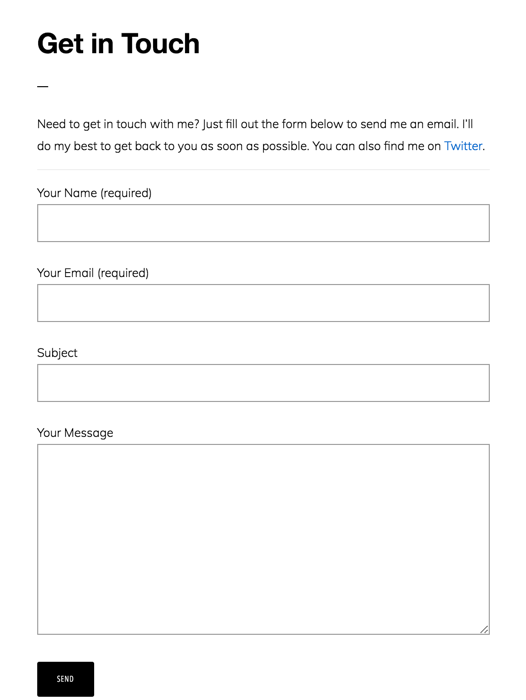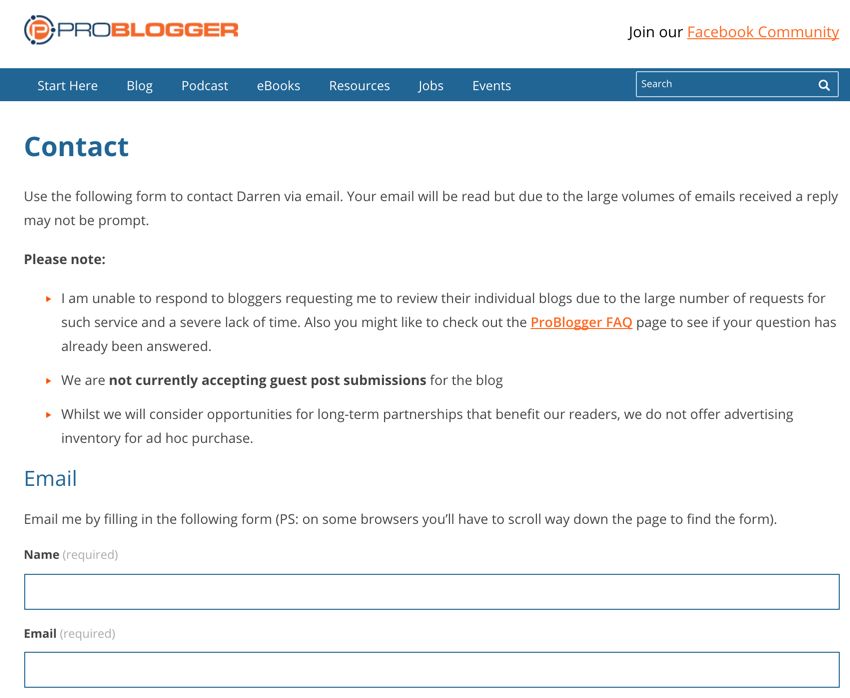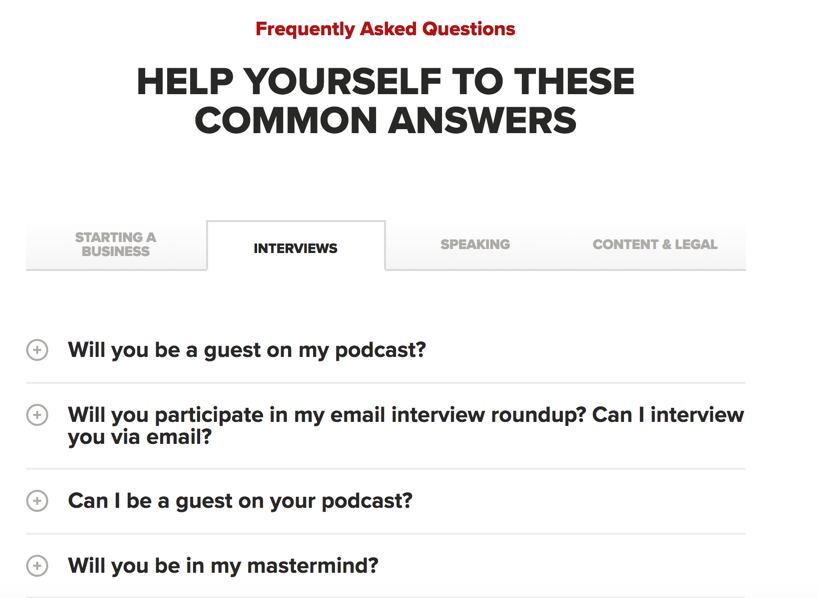 As you know, most blogs have a contact page. It’s one of the first pages we create when we’re building a new blog. We want people to be able to shower us in praise, offer us lucrative advertising and book deals, and beg us to create wonderful products for them, right?
As you know, most blogs have a contact page. It’s one of the first pages we create when we’re building a new blog. We want people to be able to shower us in praise, offer us lucrative advertising and book deals, and beg us to create wonderful products for them, right?
Okay, so that might be stretching things a little. But we do want people to be able to get in touch with us. Blogging is about connecting with people after all.
It’s easy to add a simple form to a contact page using a WordPress plugin such as Contact Form 7, Ninja Forms or Gravity Forms (my personal favourite). But what you might not realise is that a contact page can become a burden.

A simple contact form
In the early days of a new blog, a contact page might generate a handful of emails each week that you can read and respond to in no time at all.
But as our blogs grow, those emails can become difficult to handle. When my blog took off several years ago, I found myself spending so much time dealing with contact form emails that it began to have an impact on my blogging.
The biggest problems I noticed at the time were:
- Readers sending me urgent questions I felt pressured to respond to immediately.
- Readers sending me the same questions over and over, which forced me to choose between writing the same response over and over or not responding at all.
- Not being able to distinguish between important and unimportant emails. I had to click through every contact email to see what they were about, then go back and process them in order of most to least important. Each email got handled twice.
- Customers asking me to do things they could do themselves through my ecommerce system. For example, asking for another copy of the eBook files they’d lost, not realizing they could log in to the store at any time and download them.
Today I can handle my contact page requests in a single ten-minute block each morning. For the rest of the day only the highest priority emails come to my attention.
But you don’t need an overflowing inbox to take the steps I’m about to recommend. You can turn your contact form into an efficient productivity right from the start.
Setting Expectations
No matter how big your blog is, the first step is to remove the expectation that you’ll respond immediately. I live in a time zone (the east coast of Australia) where most of my contact form submissions happen while I’m asleep and are waiting for me in the morning.
On my contact form I have a simple message:
“Thanks for contacting me! I’m located on the east coast of Australia, GMT+10, and check my contact form submissions once per day, so please be patient and I’ll get back to you as soon as possible.”
That message immediately lets people know I won’t respond straight away. If their problem is super urgent, they’ll ask somewhere else to get a faster answer. And that’s fine. But they won’t just stare at their inbox, getting angry because I’m ignoring them.
Darren takes it a step further on the ProBlogger contact page. He makes it clear that not all emails will get a response. He also makes it clear which emails he won’t respond to.

The ProBlogger contact page
By setting these expectations, Darren and his team can reduce the amount of email they receive, and give themselves more time to focus on the emails they do handle.
Triaging Contact Emails
One of the first steps I took in dealing with my contact page emails was to set up an inbox rule that moved them all to a specific folder. That stopped them cluttering up my inbox, and meant I could process them in batches once or twice a day.
Unfortunately, having dozens of emails with a subject line of ‘New contact form submission’ wasn’t any more efficient.
Different emails have different priorities. An advertising request won’t have the same priority as a question from a reader. The challenge is to sort them by priority so you can deal with the important ones first – especially on those busy days when you can’t get to them all.
My solution was to add a drop-down list to my contact form that let the visitor choose a reason for contacting me. Here’s the list of ‘reasons for contact’ I’m using at Left Brain Blogging.

Let visitors tell you why they’re contacting you
All of the WordPress plugins I mentioned earlier will let you create a drop-down list.
Another option is to use a “Subject” field for the visitor to tell you why they’re contacting you. But you may end up with too many generic subject lines (“I need help!”), which doesn’t help with your triage.
This simple change had an immediate impact on my efficiency. On busy days I could action the customer service requests first, and leave general questions for later in the day or even the following day. And while it could mean leaving an email unanswered, my next tip will help you avoid that problem.
Answer Questions Before They’re Asked
At some point you’ll run out of time to process every contact email you receive. The obvious solution is to reduce the email load. The fewer emails you receive, the fewer emails you’ll potentially ignore.
Any question you can answer before a person even submits the contact form is a win-win situation. They get a fast answer, and you save time not having to write an individual answer. But to do that, you need to apply several steps together.
The first step is to identify patterns in the requests you’re getting. By processing your emails in batches you’ll quickly recognize questions that get asked again and again..
The second step is to answer those questions right there on your contact page. By adding a frequently asked questions (FAQ) section, you’ll be able to provide answers to them all. At Smart Passive Income, Pat Flynn has built up an extensive FAQ on his contact page because he receives so many similar requests.

Pat Flynn’s contact page FAQ
If a question needs a more detailed answer, take a few minutes to write a blog post and then link to it from your FAQ. The extra content on your blog could even help with search engine traffic.
If you’ve set up a “reason for contact” drop-down list in your form, you can use conditional logic to display different FAQs based on whatever reason the person selected. Ninja Forms and Gravity Forms both have this capability as a paid feature.
The final step is to add a note to your contact page encouraging visitors to search your site’s search function. They might not realize you already have blog posts that answer their questions. (You may also need to make your search box easier to find.)
Outsource
No matter how efficient you get at handling contact emails, there will come a day when you won’t want to deal with them yourself any more. You may decide your time is too valuable to be answering basic requests. Or you might just be sick of dealing with all those emails.
There’s no shame in this. Most blog-based businesses hit a natural ceiling at some point, unable to scale beyond what a single blogger can achieve each day.
At this point you’ll probably start look at outsourcing it to a staff member or virtual assistant. But unless you’re already doing what I’ve suggested in this post, your outsourcing could end up being messy and inefficient.
To give it the best chance of success, get your systems in place before you outsource. For example:
- Set expectations about response times so you can hire someone to perform the job at a specific time of day. Having your VA process all contact emails at 7am means you’ll only have a few leftover exceptions to deal with you sit down at 8am.
- Set up a “reason for contact” drop-down so you can route each request according to its subject line. If a customer has a support request for the product they purchased, route it to your customer service ticketing system for your team to handle. And have requests for information about your sponsored post rates routed directly to you so you can follow up on it personally.
- Use FAQs to defer requests and reduce the amount of emails you receive. It will reduce the number of hours your VA or staff member spends handling those emails.
Where to Start
In this post I’ve given you tips and strategies for turning your contact page into a productive tool so you can run your blog and your business more efficiently.
But what’s the best way to implement them all? Here’s what I suggest.
- Add a note to your contact page that you’ll be processing your emails only once a day (to set expectations).
- Create an email rule that automatically moves all your contact emails to a folder, and then set time aside each day to batch process them. Start keeping notes on the requests that keep cropping up, along with those you’d rather not receive at all.
- Add a “reason for contact” list to your contact form so you can prioritize emails when you’re batch processing them.
- Start adding FAQs that answer the most common questions to reduce your email load.
- Review your “reason for contact” list and FAQs regularly to control the amount of email you’re receiving. Whenever it feels like you’re answering the same question again and again, add it to your FAQ.
- If you’ve made things as efficient as possible but you’re still handling too much email, look at outsourcing.
Hopefully these tips will help you save time and improve your productivity. But if you have any questions, feel free to leave a comment and I’ll answer them as soon as I can.
